The Crescent Moon Moves from Morning to Evening, Planets Primarily in Pre-dawn, and the Lion Leads Spring Galaxies West!
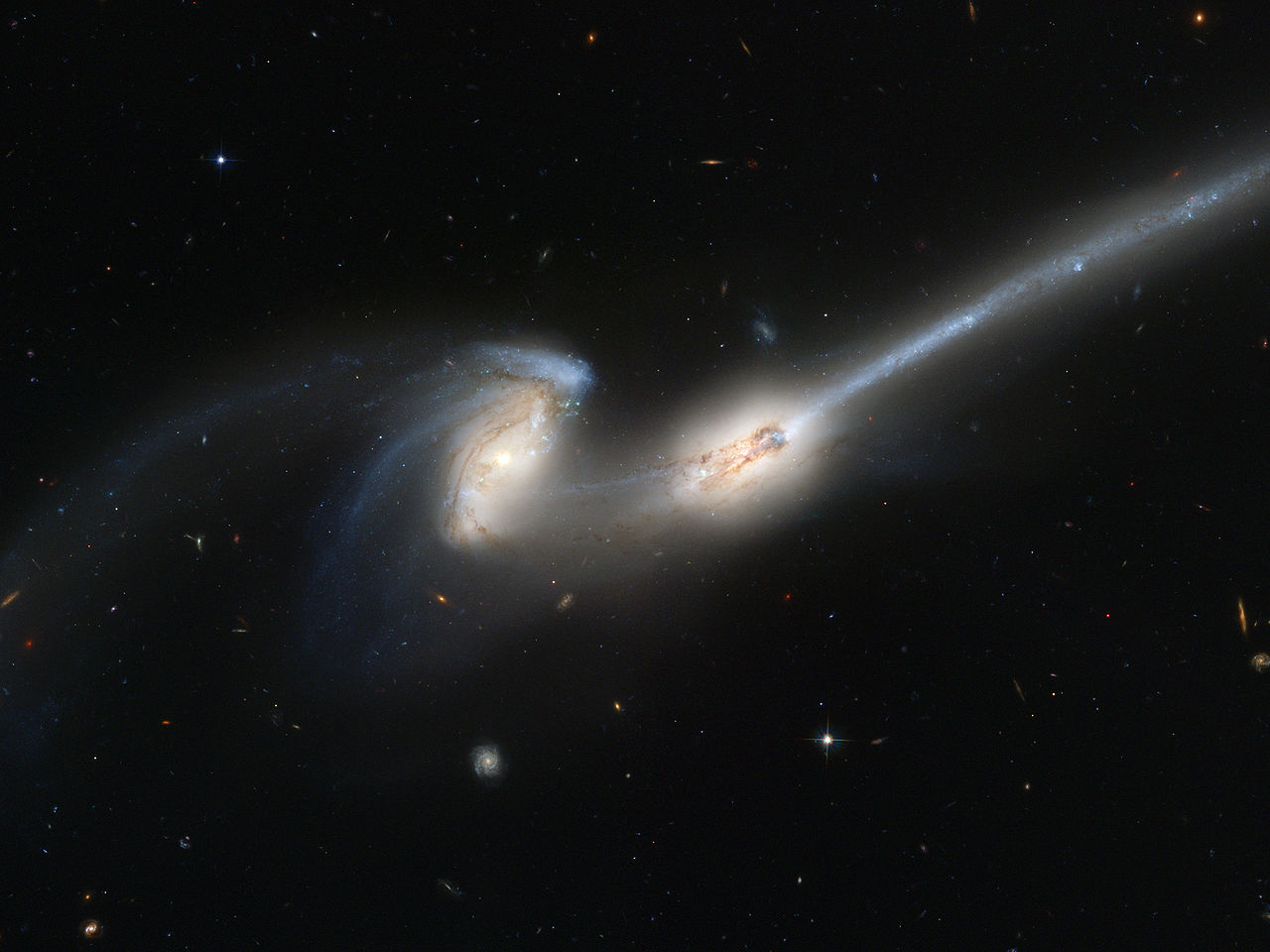
This image of the Mice Galaxies (NGC 4676) obtained with the Hubble space Telescope. The two galaxies, 300 million light-years away from us, are in the process of merging, tugging on one another with gravity. Eventually, the stars will coalesce, likely into a far less interesting-looking elliptical galaxy. For now, the streams of stars extending outward are the “tails”. The image here spans an area in northern Coma Berenices equivalent to 10% of the diameter of a full moon. Distorted galaxies like this are part of Halton Arp’s catalogue of Peculiar Galaxies. This pair are Arp 242. (NASA)
Hello, Mid-Spring Stargazers!
Here are your Astronomy Skylights for the week of May 5th, 2024 by Chris Vaughan. Feel free to pass this along to your friends and send me your comments, questions, and suggested topics. You can also follow me on Twitter as @astrogeoguy! Unless otherwise noted, all times are expressed in Eastern Time. To subscribe to these emails please click this MailChimp link.
If you’d like me to bring my Digital Starlab portable inflatable planetarium to your school or other daytime or evening event in Simcoe, Grey, and Bruce Counties, or deliver a virtual session anywhere, contact me through AstroGeo.ca, and we’ll tour the Universe, or the Earth’s interior, together! My book with John A. Read entitled 110 Things to See With a Telescope is a guide to viewing the deep sky objects in the Messier List – for both beginners and seasoned astronomers. DM me to order a signed copy!
We’re midway through spring and the sky is taking a lot longer to get truly dark. The old moon will pass the sun and return renewed as a crescent after sunset starting on Thursday, leaving the evening sky this week dark enough to chase more spring galaxies and to peruse the best parts of Leo, the Lion. With Jupiter and Venus hidden close to the sun, the other planets are gathered in the eastern sky before dawn – but they won’t climb especially high for mid-northerners. Read on for your Skylights!
We’re halfway through spring – astronomically! At the latitude of Toronto the sun is setting about a minute later per day and the amount of daylight is increasing by 2.5 minutes with each passing day. Already, stargazers need to wait until about 10:20 pm for the sky to truly darken. That wait will extend to 11:30 pm around the June solstice.
The Moon
Earth’s natural satellite will play a bit of peek-a-boo this week. For those of us in pursuit of spring galaxies in the evening, the moon’s light won’t brighten the night sky until Thursday. Then our natural night-light will return to the early evening sky on the coming weekend. I was under the stars with my telescope on several nights last week – my first opportunity for clear, moonless skies this spring. I looked at a number of galaxies for the first time – including a galaxy cluster in Coma Berenices that is 320 million light years away from us, the speck of light from a quasar in Virgo (the Maiden) that has been journeying across the universe for 2.4 billion years (!), and the Mice – a pair of galaxies that are entwined in a slow-motion dance that will see them merge long from now. I’ll share some pictures that other folks took of those objects here.
The moon is currently west of the sun in the sky – meaning that it will set in the west before sunset and then its waning crescent will shine above the eastern horizon before sunrise on Monday morning. Early risers on Monday can also look for Mercury’s dot a few finger widths to the moon’s lower right (celestial south) and medium-bright Mars and Saturn way off to the upper right. The moon and Mercury will be cozy enough to share the view in binoculars after they rise around 5 am local time and remain in sight until the brightening sky hides them. Folks living near the tropics might see the moon at dawn on Tuesday morning, accompanied by the bright dot of Venus. Mercury will then be well to the moon’s upper right.
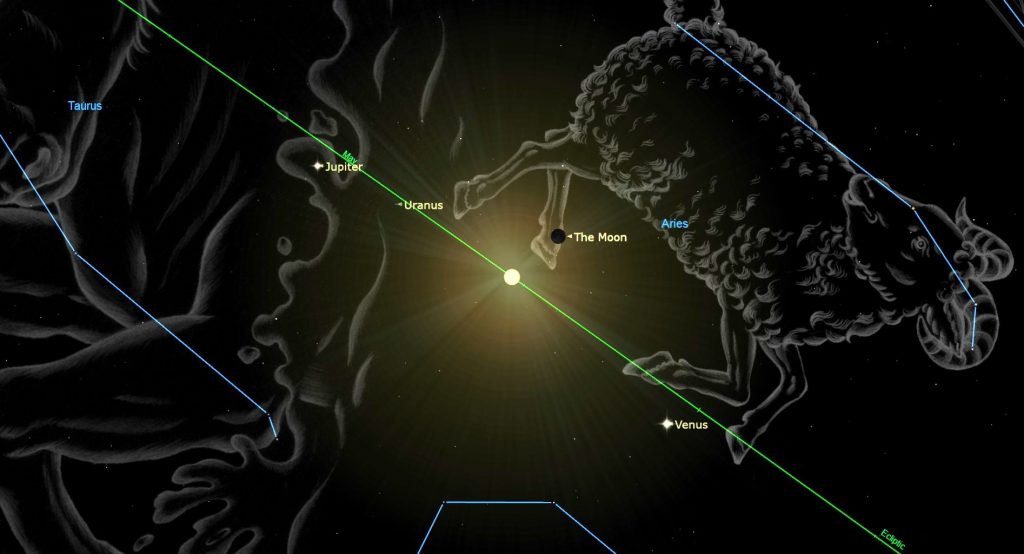
The moon will officially reach its new moon phase on Wednesday, May 8 at 03:22 Greenwich Mean Time, which converts to 11:22 pm EDT and 8:22 pm PDT on Tuesday evening. At new, our natural satellite will be located between Venus and Jupiter in Aries (the Ram), and less than 2 degrees north of the sun. While at its new phase, the moon is travelling between Earth and the sun. Since sunlight can only shine on the far side of the moon, and the moon is in the same region of the sky as the sun, it becomes completely hidden from view from anywhere on Earth for about a day.
The very slender crescent of the young moon will sit above the sun when it sets on Wednesday, but we’ll need to wait until Thursday to see its pretty Cheshire Cat’s smile shining in the lower part of the western sky after sunset. Earthshine will brighten the moon from Thursday to Saturday. Sometimes called the Ashen Glow or the Old Moon in the New Moon’s Arms, the phenomenon is visible within a day or two of new moon, when sunlight reflected off Earth and back toward the moon slightly brightens the unlit portion of the moon’s Earth-facing hemisphere.
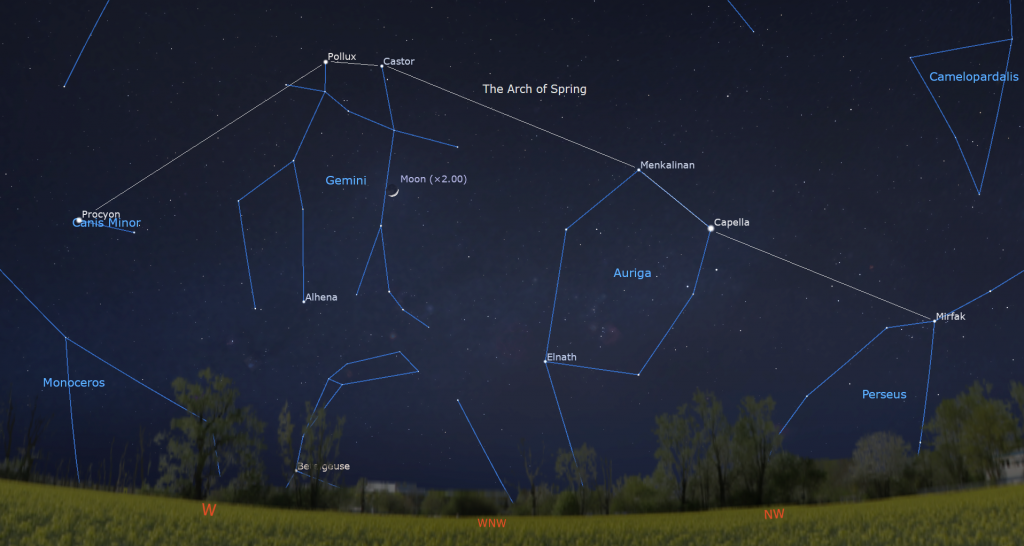
Once it’s dark on Friday the bright stars of the Arch of Spring asterism will sparkle above the slender moon. Starting from the left they are: white Procyon (Alpha Canis Minoris), white Castor and golden Pollux (Alpha and Beta Geminorum respectively), yellow Capella (Alpha Aurigae) and the fainter white star Menkalinan to its upper left, and the bright star Mirfak in Perseus (the Hero).
The moon will be brighter and closer to Castor and Pollux on Saturday evening. This time of the lunar month is ideal for viewing the moon under magnification. On Saturday, the moon’s crescent will host the dark oval of Mare Crisium. This 556 km diameter basin is easy to see using your unaided eyes, binoculars, and any telescope. It is located near the eastern edge of the moon, just north of the moon’s equator. The slow wobble of the moon that astronomers call lunar libration shifts Mare Crisium higher and lower, and closer and farther from the moon’s edge at various times. Make note of it and check again next month!
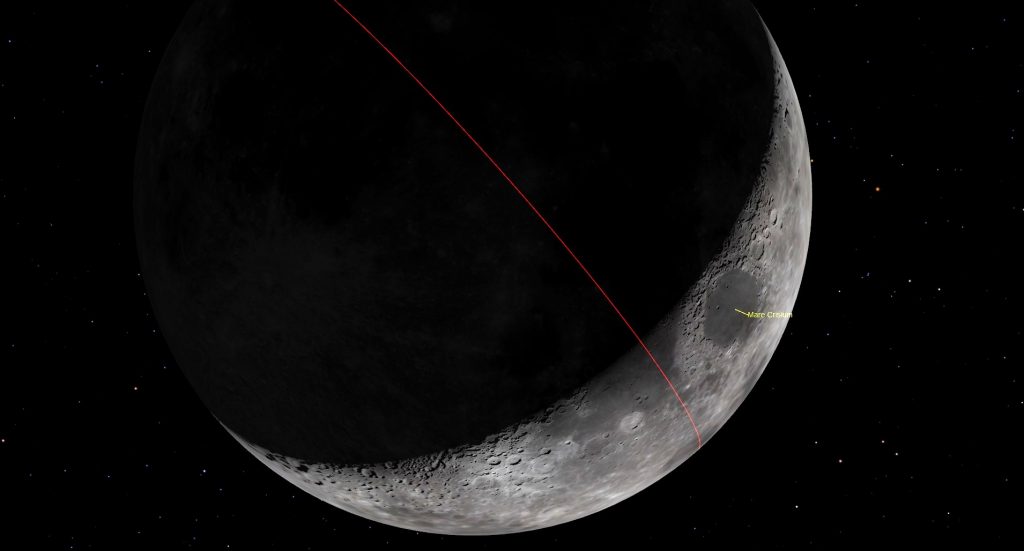
To end this week, the pretty, waxing crescent moon will align with Pollux and Castor on next Sunday evening. Pollux, the brighter and more yellowish of the “twins”, will be close enough to the right of the moon for them to share the view in binoculars. The slightly fainter and whiter double star Castor will sparkle farther to their right (or celestial northwest). The trio will set around 1 am in your local time zone. For observers in more westerly time zones, the moon’s orbital motion will carry it farther from Pollux.
The Planets
While bright Jupiter and faint Uranus are both located above the setting sun this week, only Jupiter is bright enough to see – and only if your western horizon is haze-free. Celestial objects set in the west because our location on the Earth is continuously rotating away from the western sky and towards the eastern sky. Meanwhile, the distant, background stars are carried towards the sun due to Earth’s orbital motion – at a rate of about 4 minutes per day, or half an hour per week. A star viewed at the same time on consecutive evenings will be positioned lower in the western sky. That’s why we see different constellations each season. The planets are much closer than the background stars. Even though they are moving with respect to those stars, they, too, are carried sunward (i.e., down in the west) night after night.
Jupiter is sinking lower and closer to the sun daily, and its intensity is being reduced as it shines through an increasingly thicker blanket of Earth’s atmosphere. We’ll lose sight of Jupiter this week. The big planet will remain hidden while it passes the sun at solar conjunction on May 18 and then it will enter the morning sky. Jupiter won’t return to visibility at mid-northern latitudes until June.
There will be no other planets to look at, from anywhere on Earth, until Saturn rises at around 4 am local time. At mid-northern latitudes, the yellowish planet will catch your eye above the eastern rooftops around 5 am local time and persist until the sky brightens. Neptune and Mars will rise about 20 minutes and 30 minutes after Saturn, respectively. Normally, planets become easy to see once they swing to a substantial angle away from the sun because they well before the sun does. But the very tilted morning ecliptic nowadays is putting the planets more to the right of the sun than above it. That makes the sky begin to brighten soon after they rise and its holds all three planets low in the sky.
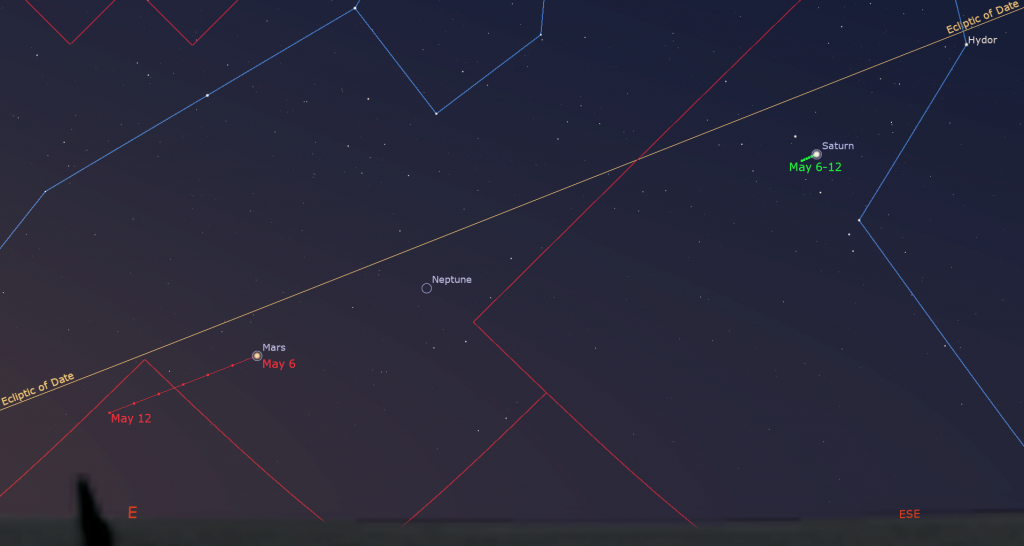
If you are not keen to set the morning alarm to see planets, wait a while. Saturn will start to rise before midnight after the first week of July, and then 30 minutes earlier for each week after that. I’m excited to see Saturn this year. Its rings, which will effectively disappear when they become edge-on to Earth next March, already appear as a very narrow slash across the planet’s globe. Earth’s perspective of the Saturn system this year and next will produce frequent transits of Saturn’s moons across its disk.
Once reddish Mars clears the treetops around 5 am local time, you can use it to find Neptune. The blue planet’s meagre, magnitude 7.9 speck will be hard for casual stargazers to see, especially because the sky will brighten before Neptune is lifted above the denser air over the horizon. Mars has been racing east along the ecliptic, outrunning slower Saturn and Neptune and increasing its distance from them. On Monday morning, Neptune will be almost a palm’s width from Mars, and offset in the direction of Saturn. Next Sunday morning, Neptune will be a fist’s width from Neptune. Like Saturn, Neptune will be a star-party target from late summer on.

Bright Venus is still peeking above the eastern horizon before the sun rises – but like Jupiter in evening, it’s too close to the sun to be easily observable. Venus will approach the sun until it reaches solar conjunction in early June. Later this year it will re-appear as the “Evening Star”.
Last week, Mercury began to climb into view above the eastern horizon before sunrise. On Monday morning, it will rise around 5:15 am local time (and pose near the old crescent moon). On Friday, Mercury will reach its greatest angle (26.4 degrees) from the morning sun and maximum visibility for its current morning apparition. With Mercury positioned well below the tilted morning ecliptic, this appearance of the innermost planet will be a poor one for Northern Hemisphere observers, but an excellent one for those viewing from the tropics and the Southern Hemisphere. The optimal viewing times at mid-northern latitudes will start around 5:15 am local time. Viewed in a telescope, the planet will exhibit a waxing, almost half-illuminated phase. Turn all optics away from the eastern horizon before the sun rises.
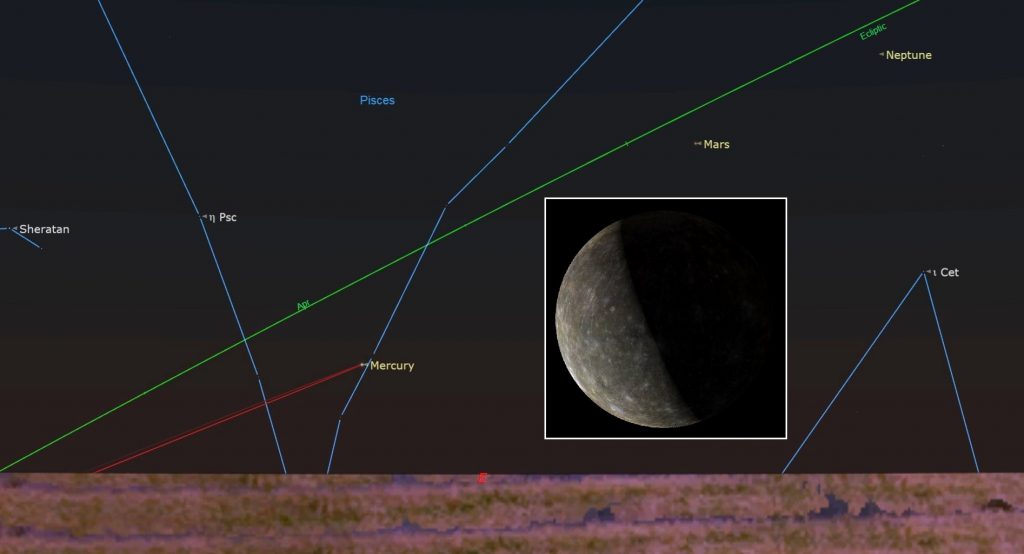
Eta-Aquariids Meteor Shower
The annual Eta-Aquariids Meteor Shower is produced when Earth’s orbit carries us through a cloud of particles left behind by repeated passages of Halley’s Comet. The shower, which runs from April 19 to May 28, will peak in intensity tonight (Sunday evening, May 5) in the Americas – and there will be no moonlight to spoil the show! I saw several of them last week! While some meteors should be visible on Sunday after dusk, more should appear once the shower’s radiant point in Aquarius (the Water-Bearer) rises above the southeastern horizon around 3 am local time on Monday morning. A few dozen meteors per hour are typical during the peak – including some fireball meteors – and they can arrive in bursts. Its southerly radiant makes the Eta-Aquariids shower better for observers located closer to the tropics.
Leo the Lion and His Galaxies
Last week I highlighted spring galaxy-viewing season, the annual window when the Milky Way drops to the horizon, leaving the evening sky overhead free of its obscuring gas and dust, and letting us peer into the deep Universe at the other galaxies there! We’ve got one more week to chase those galaxies – but there is plenty to see even if you don’t have a big telescope or live in a dark, rural location. Leo (the Lion) is well worth your attention.
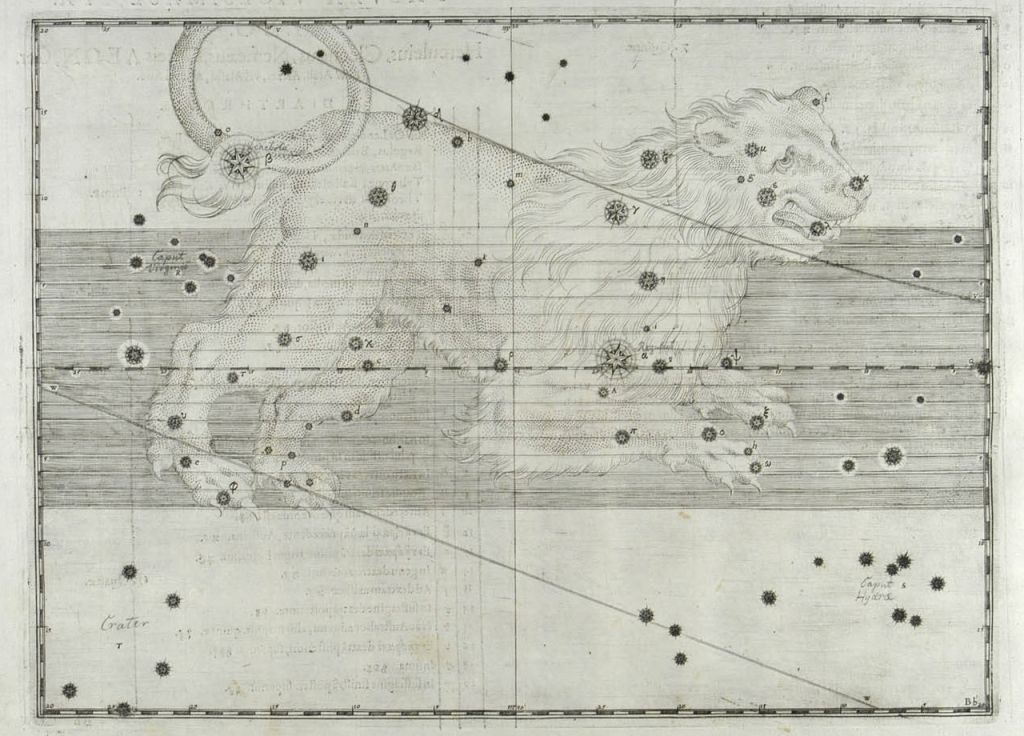
For millennia, sky-watchers have imagined the stars in the night sky linking into patterns – forming humans and animals and inanimate objects. We call these groupings constellations, after the Latin for “stars grouping together”. Each culture has assigned their own spin on the heavens, usually naming the patterns after things in their everyday experience. For example, south sea islanders saw outrigger canoes. The Inuit in the north saw the Big Dipper as the Caribou and nearby Cassiopeia’s “W-shape” as the Blubber Container, with a Lamp Stand shining nearby.
In modern-day astronomy, the entire sky is divided into 88 officially recognized constellations. The manner in which the stars are connected into stick figures is not regulated, but the boundary lines between the constellations are. That way, there are no gaps in the coverage, and every object in the heavens can be placed within one of the 88 regions. The western approach is not the only option, though. Astronomy has a long tradition in China – and they connected smaller groups of stars, yielding several hundred Chinese asterisms or 星官, xīngguān. Indigenous groups of North America and elsewhere had their own interpretation of the sky, and often used the stars to teach valuable lessons and preserve their traditions.
A handful of constellations are so obvious that many independent cultures assigned the same meaning to those stars. A perfect example of that is the spring constellation of Leo (the Lion). The lion was identified as early as 1,000 BCE by the Babylonians, and later by the Egyptians, Greeks, and Romans. To the Greeks it represented the Nemean Lion slain by Hercules during his labours. Only that beast’s own claws were sharp enough to slice its hide.
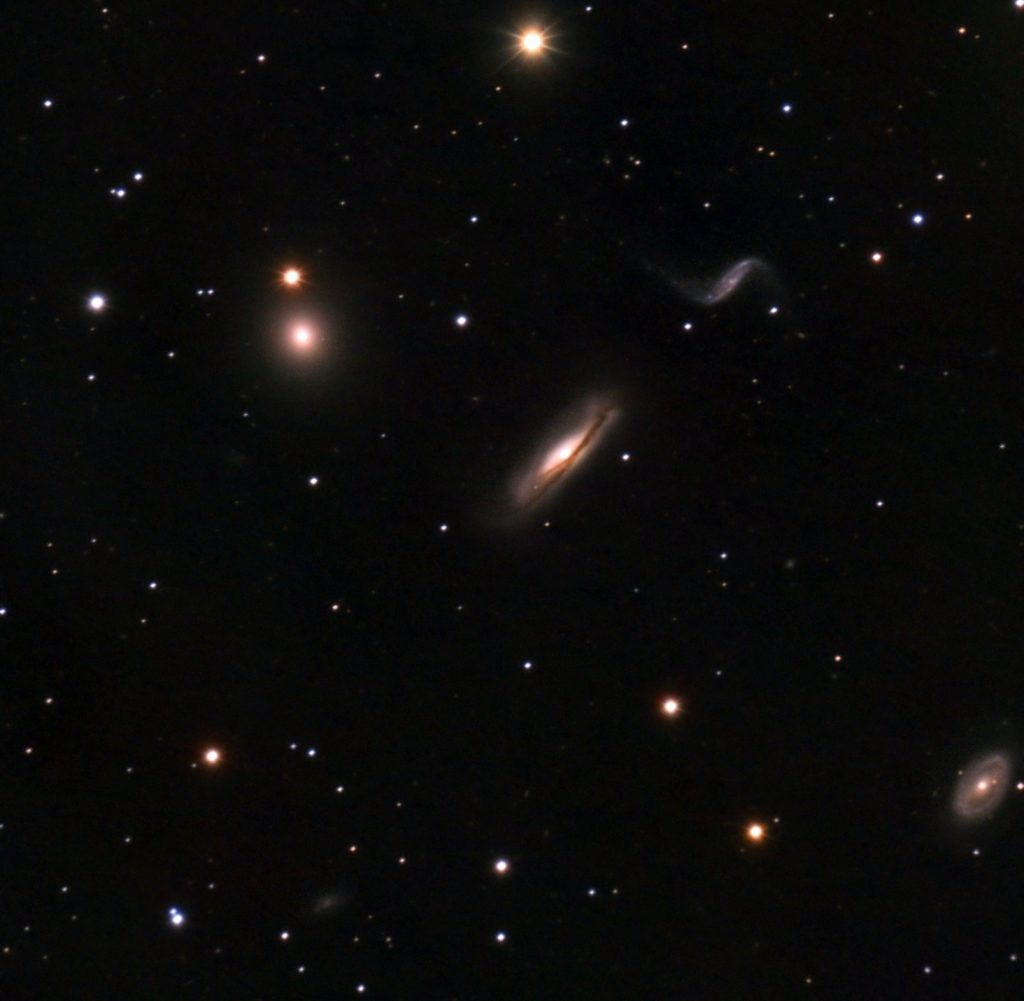
It’s easy to find and recognize Leo, even from suburban skies. Head out on the next clear evening and face south. Leo is a large constellation situated about halfway up the evening sky. The imaginary ecliptic line that the sun, moon, and planets all travel close to crosses through the lion’s territory (though all of his bright stars are north of it). For this reason, Leo is one of the twelve zodiac constellations. He is positioned with his head facing down to the right (celestial west) and his tail up towards the left (east). In some depictions, he has no legs or feet, as if he’s got them tucked underneath himself! On early May evenings, the lion will descend headfirst in the west and set during the wee hours.
The lion’s brightest star is Regulus (or Alpha Leonis). Regulus means “Little King” in Latin and its Arabic name Qalb Al Asad translates to “the heart of the Lion”. Regulus, the 21st brightest star in the heavens, is a blue-white star with a small, nearby companion star that can be seen in binoculars or a backyard telescope. Its position very close to the ecliptic allows it be occulted frequently by the moon and the inner planets.
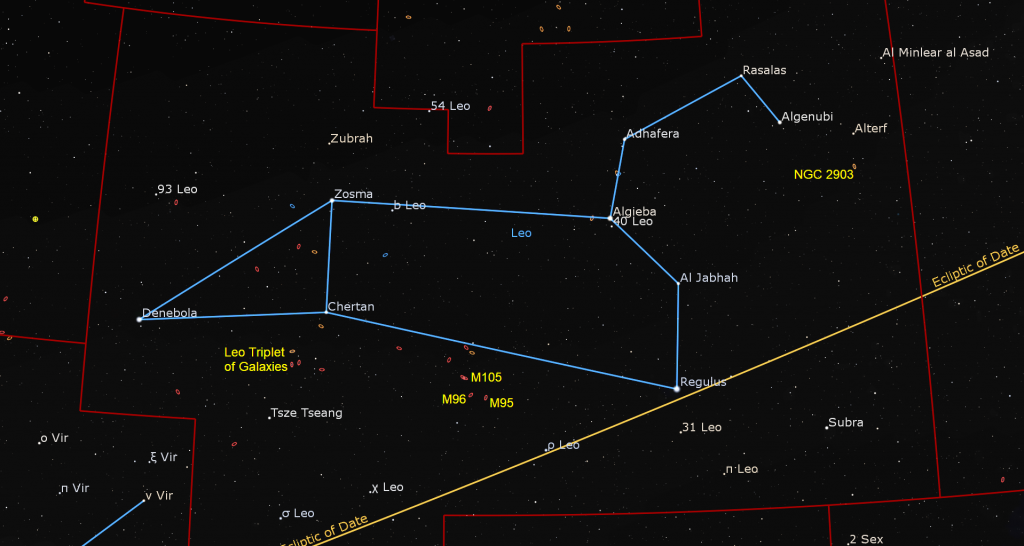
From Regulus, look upwards and trace out another five modestly bright stars arranged in a backwards question mark about 1.4 fist diameters tall with Regulus serving as the “dot”. Some people see a sickle. The shape represents the lion’s neck, head, and mane. The medium-bright, white star that sits a slim palm’s width above Regulus is Al Jabhah (or Eta Leonis). It emits up to 20,000 times more light than our own sun, but its distance of 1,270 light-years makes it dim enough to shine near the limit of visibility for suburban stargazers.
The second star up from Regulus shines several finger widths to the upper left (or 4° to the celestial northeast) of Al Jabhah. This is a brighter star named Algieba, or “the forehead”. In a backyard telescope, Algieba splits into a very pretty yellow and blue pair of stars, one slightly brighter than the other. A third star shines well-separated from the pair. The medium-bright, yellowish star positioned above Algieba is Adhafera (or Zeta Leonis), which comes from the Arabic aḍ-ḍafīrah “the braid/curl”, possibly a reference to its position in the lion’s mane. The star is flanked by two bright companion stars that are visible in a backyard telescope.
The next star, found with a larger hop toward Adhafera’s right, is Rasalas or Ras Elased Australis (or Mu Leonis), an abbreviation of Al Ras al Asad al Shamaliyy, which means “The Lion’s Head toward the South”. Yellow-tinted Rasalas is only about 125 light-years away from us, and is known to be orbited by a giant planet. At the end of the sickle, below Rasala, we find medium-bright, yellow star Algenubi (or Epsilon Leonis), which marks the beast’s nose. Both Algenubi and Ras Elased Australis mean “the Southern Star of the Lion’s Head”.
A fainter, reddish star named Alterf (or Lambda Leonis) shines just a few finger widths in front (west) of the lion’s nose. The name arises from the Arabic word Aṭ-ṭarf “the View (of the Lion)”. A very similar red star named 31 Leonis shines a short distance below Regulus. And, an even redder star named Pi Leonis shines two finger widths below 31 Leonis. Check them out in binoculars!
Let’s trace out the rest of the lion. Starting from Algieba, cast your gaze a generous fist’s width to the upper left (or 13° to the celestial east) to find a star of similar brightness named Zosma (or Delta Leonis). It represents the lion’s hip. Zosma is a hot, white star about twice the diameter of our sun – although its rapid spin (100 times faster than our sun’s) has given it an oblate form. We know so much about the star because it is only 54 light-years away from us.
Angling down and to the left of Zosma by another fist’s width, we reach the star marking the lion’s tail, Denebola (or Beta Leonis), the second brightest star in the constellation. Denebola is a young, blue-white star only a few hundred million years old. It emits quite a bit of infrared radiation, suggesting that this young sun may have a planet-forming dust disk around it. It’s a mere 36 light-years away from us!
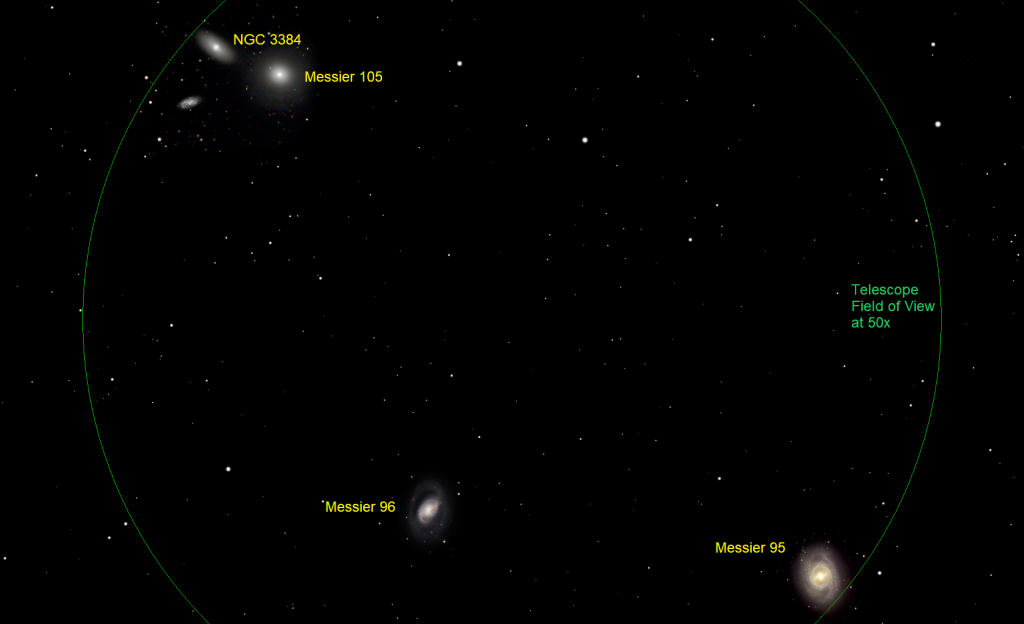
The last major star of Leo, named Chertan (or Theta Leonis), sits below and between Zosma and Denebola, forming a nice triangle with the other two stars. The name Chertan is derived from the Arabic al-kharātān “Two Small Ribs”, which originally referred to the up-down line it formed with Zosma.
Draw an imaginary line from Zosma to Chertan and triple its length. If you aim your binoculars at that seemingly empty patch of sky you’ll discover a rough circlet of medium-bright stars about a fist’s width (or 10 degrees) across named Sigma, Tau, Upsilon, Epsilon, Phi, p, and d Leonis. I like to think of them as outlining the mouth of the lion’s den.
Now that you see the lion – can you see the mouse? It’s easy to imagine the sickle of stars as a mouse’s curly tail, and Denebola and Zosma as the mouse’s nose and eye!
Leo is a favorite of amateur astronomers because it contains a nice selection of relatively nearby and bright galaxies – and Chertan is your guidepost to finding them!
A medium-bright star named Iota Leonis (or Tsze Tseang in some apps) shines to the lower left (or celestial south-southeast) of Chertan. (It’s the same distance from Chertan that Zosma is.) On a moonless night in a location away from city lights, aim your big binoculars or a backyard telescope halfway between Chertan and Iota. There, you should see a clump of three spiral galaxies known as the Leo Triplet. All three galaxies will share the eyepiece in a good telescope at low magnification. Two of the galaxies sit closer together. Those are numbers 65 and 66 on Charles Messier’s famous list of deep sky objects, so astronomers call them M65 and M66. A third, fainter galaxy sits a little bit apart. That’s the Hamburger Galaxy or NGC 3628, so-named for its distinctive shape.
A second, more widely separated group of galaxies is located midway between Chertan and Regulus, and two finger widths below the line joining those two stars. Named the Leo I Group, it contains M95, M96, and M105 – plus another galaxy not catalogued by Charles Messier named NGC 3384. (NGC stands for New General Catalog.)
And that’s just the beginning. A very nice and bright spiral galaxy named NGC 2903 sits just a thumb’s width to the lower left (or 1.4° to the celestial south of) the star Alterf. I’ve taken to calling it the Lion’s Tongue Galaxy.
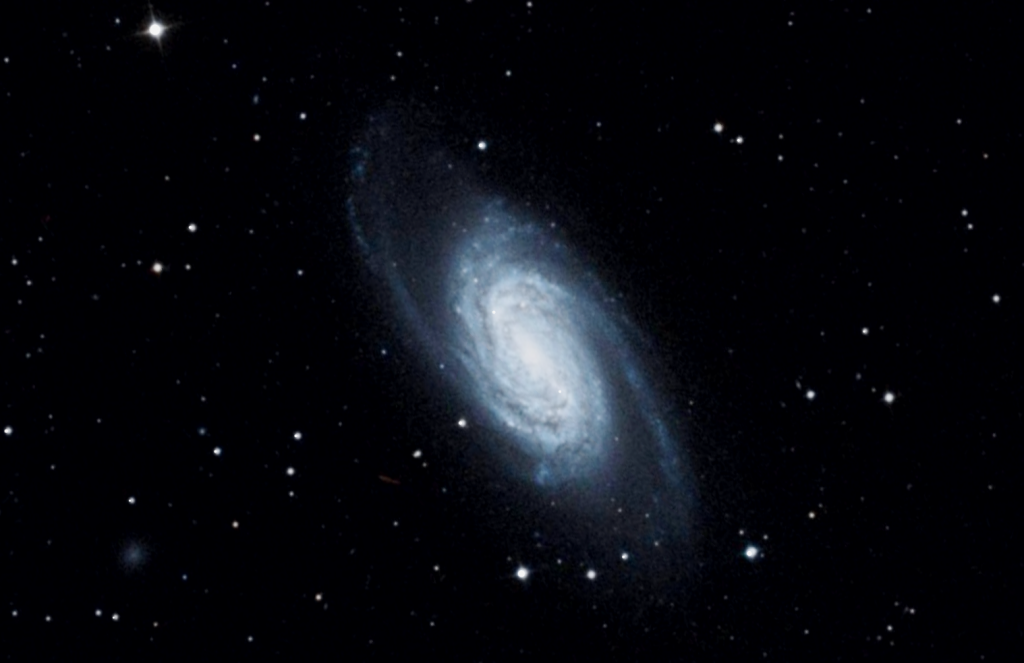
The patch of sky located about a fist’s diameter to the rear of Denebola contains the dozens of bright galaxies in the Virgo Cluster. I wrote about them last week. The left-hand (eastern) portion of Leo hosts more clusters of galaxies that are best seen in large telescopes or long exposure photographs.
If you’d like to watch me deliver a deep dive into Leo’s best features, the YouTube link to it is here.
Public Astronomy-Themed Events
Every Monday evening, York University’s Allan I. Carswell Observatory runs an online star party – broadcasting views from four telescopes/cameras, answering viewer questions, and taking requests! Details are here. They host in-person viewing on the first clear Wednesday night each month. Other Wednesdays they stream views online via the observatory YouTube channel. Details are here.
On Monday, May 6 at 8:30 pm, the U of T 2024 Martin Lecture in Astronomy & Astrophysics will feature Maria Zuber – the first woman to lead a science department at the Massachusetts Institute of Technology and the first to lead a NASA planetary mission. Her presentation titled A Human Expedition to Mars will take place at Innis Town Hall, 2 Sussex Ave. Toronto, ON. It will also be streamed online. More information and the registration link are at https://rascto.ca/events/uoft-lecture-human-expedition-mars.
On Saturday, May 11 from 9:30 am to 4 pm, you can tour the historic David Dunlap Observatory during Doors Open Richmond Hill. Registration will be required. More information is available at https://rascto.ca/events/doors-open-richmond-hill-2024-ddo.
On Saturday, May 11 from 10 am to noon, you can try out Solar Observing at the Ontario Science Centre! If it’s sunny, members of the RASC Toronto Centre will be setting up outside on the Teluscape in front of the main doors. They’ll have an array of special equipment designed to view the Sun safely. This is free to the public, but parking and admission fees inside the Science Centre will still apply. Check the RASC Toronto Centre website or their Facebook page for the Go or No-Go notification.
Spend some time in the other dome at the David Dunlap Observatory! On Saturday, May 25, you can join me in my Starlab Digital Planetarium for an interactive journey through the Universe at DDO. We’ll tour the night sky and see close-up views of galaxies, nebulas, and star clusters, view our Solar System’s planets and alien exo-planets, land on the moon, Mars – or the Sun, travel home to Earth from the edge of the Universe, hear indigenous starlore, and watch immersive fulldome movies! Ask me your burning questions, and see the answers in a planetarium setting – or sit back and soak it all in. Please note that all guests will sit on a clean floor. A registered adult must accompany all registered participants under the age of 16. We run sessions geared to junior astronomers in the morning and family sessions in the afternoon. Registration is required. More information and the registration links are here.
Keep your eyes on the skies! I love getting questions and requests. Send me some!